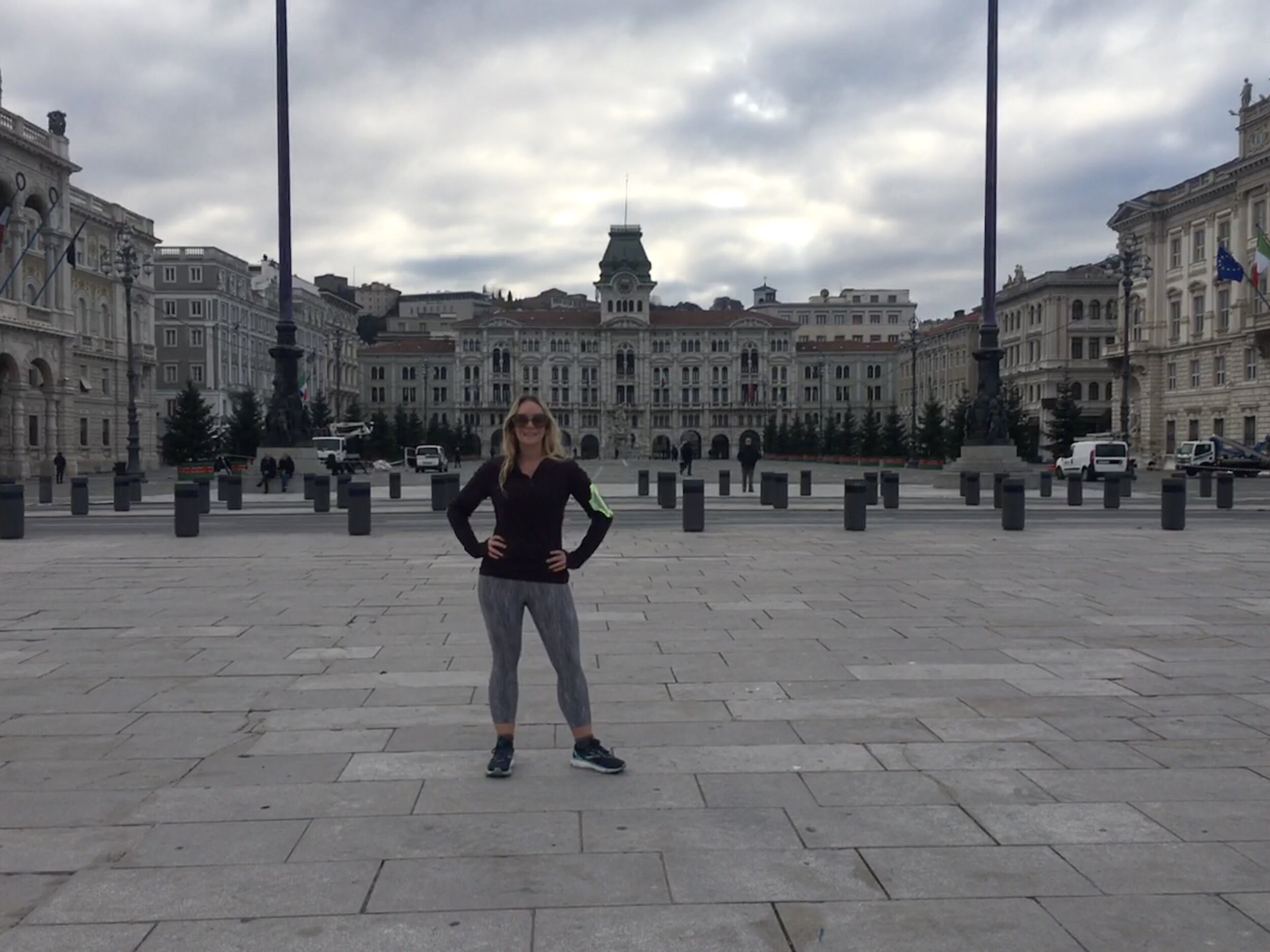Spots in Trieste
Piazza dell’unita D’italia
This is said to be the largest seafront piazza in Europe. Indeed, the piazza opens up into the vast Adriatic sea and the views are expansive all around. Facing inward with the sea to your back, the Palazzo del Municipio (Municipal building/City Hall) with the central clock tower meets your gaze. The architecture is Viennese-style as it was built at the end of the 19th century when Trieste was still a part of the Austria-Hungarian Empire. According to the Discover Trieste website, the creation of this grand piazza “was the final show of power, strength and solidity of a great empire that was drawing to an end.” The empire was dissolved in 1918, at the end of World War 1. The buildings on either side of the Municipal building are the Lloyd Triestino building on the right (with back to the sea) and the Palazzo del Governo, with some golden mosaics also recalling the Art Nouveau aesthetic that graces some of the famous cafes of the city.
The vast piazza has been filled with people during key moments in history related to the world wars as well. Again, according to the Discover Trieste website: “On 2 July 1914, the boat decorated for mourning that transported the remains of Archduke Franz Ferdinand and his wife Sophie landed at the quayside of this square, marking the end of a world.” Then, in 1938, Benito Mussolini announced the adoption of the evil Racial Laws on a stage constructed in the middle of the piazza. In fact, the Risiera di San Sabba was converted into a concentration camp as detailed in the Introduction to the city of Trieste post.
If you visit the piazza at night, which you should, as it is illuminated most beautifully, you will also notice blue lights on the ground. These represent the water’s edge of the old marina. You will also notice the Fontana Dei Quattro Continenti (the fountain of the four continents) in front of the Palazzo del Municipio. Constructed between 1751-1754, this statue represents the four known continents at the time—Europa, Asia, Africa and America.
When you walk down to the current water’s edge you will see two sets of contemporary bronze statues. They were created by Fiorenzo Baci in 2004 and depict soldiers, specifically, bersaglieri, waving the Italian flag and two young seamstresses. The ‘bersaglieri’ were the first soldiers of the Kingdom of Italy to set foot in Trieste. At the time, the Austrian government was still in control of the city but that soon changed as the city was annexed at the end of World War 1. Read more about this fascinating history here. After admiring these statues continue along the waterfront for a long pleasant stroll.
I have referenced unsavory legacy of Fascism in this entry and will do so again in the description of the Parco della Rimembranza below. Unfortunately, Trieste has strong links to the Fascist regime, and you can read more in Morris’s interesting history Trieste and the Meaning of Nowhere (also linked above) and in this New York Times article about the statue of the controversial poet Gabriele d’Annunzio recently erected in central Trieste.
Castello di San Giusto and Parco della Rimembranza
I mentioned the Castello di San Giusto in the entry on restaurants as the Osteria di Mare alla Voglia is located in the vicinity. This is definitely a spot to visit for the history as well as the views. The ascent by foot is steep, but worth it, in my opinion. If you do not have major issues with mobility, I would recommend walking up to the hilltop. Start your climb at the Scala Dei Giganti (Staircase of Giants) near Piazza Goldoni, the main shopping area. Once at the top, you can visit the castle for the reasonable admission price of 3 euro. The history of the castle connects to 1382 when Trieste ‘surrendered’ to Austrian control; as conditions of ‘the act of Spontaneous Surrender to Austria’ Trieste maintained ‘independence’ but was protected by an Imperial Captain. The castle was constructed between 1468 and 1636, and the so-called ‘Captain’s House’ was one of the first important projects. Indeed, according to the official website: “The Austrian Imperial Captains resided in the castle until 1750, when it was converted for use as a garrison and a prison.” We also experienced the castle and park area after dark, which was peaceful and relaxing. The castle glows in the midst of the vast park.
The surrounding Parco della Rimembranza (Remembrance Park) is a nice place for a stroll. The ‘remembrance’ relates to all of the soldiers, Trieste natives, who have perished in war. The cause is noble, but as history is always more complex and nuanced the closer one looks, it is interesting to note that the park was created in 1926, that is, the early years of Mussolini’s Fascist reign in Italy. Some historians believe part of the motivation was ‘to exert a control over the memories related to the 1915-1918 conflict’ as many of the memorials honor soldiers from World War 1. There are also memorials to fallen soldiers in the Spanish Civil War, African wars and WW II. The intention could be a source of debate, but the lasting effect is positive, that is, honoring the memory of fallen soldiers. The park is divided into 26 sectors. I recommend taking the narrow medieval streets on the way back down the hill. These will lead you close to the 1st-2nd century CE Teatro Romano (the Roman Theatre) of Trieste, another ‘spot’ to explore, if you have more time.



